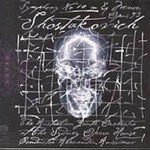
Symphony No 10 in E minor Opus 93
 $37.00
Out of Stock
$37.00
Out of Stock6+ weeks add to cart
SHOSTAKOVICH
Symphony No 10 in E minor Opus 93
Australian Youth Orchestra / Alexander Anissimov (conductor)
[ Melba / CD ]
Release Date: Thursday 1 January 2009
This item is currently out of stock. It may take 6 or more weeks to obtain from when you place your order as this is a specialist product.
"Whatever the moral implications of this massive music, the Australian Youth Orchestra give it full realization, masterfully led by Anissimov" (Four Stars AudAud.com)
"This recording celebrates 50 years of The Australian Youth Orchestra, the inscription made at the Sydney Opera House Concert Hall, 11-12 May 2005. The E Minor Symphony (1953) is ostensibly a musical portrait of the Soviet dictator Joseph Stalin, especially the sudden Allegro second movement, which follows on the heels of a vast, meditative first movement Moderato of Mahler-like proportion. One critic called the opening movement "a slow stirring to life." The clarinet melody seems lifted from Mahler's own Resurrection Symphony. A dark waltz emerges, then, with pizzicato strings in surround sound, the woodwinds ashriek, the underlying dread and terror of the period breaks forth. First and second violins play with unbroken fervor, scarcely a rest written into their parts. Flutter-tongue ravings and high piccolos (that also end the movement) swoon in some mad paroxysm of terror. This is all musical Edgar Allan Poe, and the titanic onrush of emotion has not alleviated the gloom.
The manic Allegro portrays Stalin in his emotional fury, a whirlwind militant, possessor and possessed. Great work from the battery section, the snare drum and tympani attacking from the sides while horns punctuate the terror. The flutes join the demonic band, and them the whole nightmare vanishes; everything about this movement is sudden.
The abject waltz of the Allegretto contains a series of anagrams on Shostakovich's name in musical notation: DSCH (D-E-flat-C-B). A bassoon carries the staccato motif, then the bass fiddles and horn, the latter an echo of a sentiment in Mahler. The energetic statement of this music sounds like a weary troika, an arduous trek of the spirit mounting in frustration. A riff from a violin, mumblings from the basses, some long-held notes in the horns, a viola, a flute--these make a melancholy statement about a passed tyrant whose tyranny is still in force. A slow, lugubrious opening for the Finale, then a raucous rush to judgment. A false dawn? Bitter gallows humor to sustain the composer's spirit through a nightmare that just won't go away? Whatever the moral implications of this massive music, the Australian Youth Orchestra give it full realization, masterfully led by Anissimov, whose talent I knew only from some Rachmaninov and Glazounov on Naxos."
(Four Stars AudAud.com)